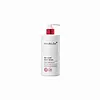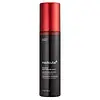What's inside
What's inside
 Key Ingredients
Key Ingredients

 Benefits
Benefits

 Concerns
Concerns

 Ingredients Side-by-side
Ingredients Side-by-side

Water
Skin ConditioningSodium C14-16 Olefin Sulfonate
CleansingGlycerin
HumectantDecyl Glucoside
CleansingCocamide Methyl Mea
Disodium Cocoamphodiacetate
CleansingSodium Methyl Cocoyl Taurate
CleansingCoco-Betaine
CleansingParfum
MaskingNiacinamide
SmoothingPropanediol
SolventButylene Glycol
HumectantSalicylic Acid
MaskingHydrolyzed Jojoba Esters
Skin ConditioningHydrolyzed Hyaluronic Acid
HumectantPanthenol
Skin ConditioningLavandula Angustifolia Extract
Skin ConditioningThymus Vulgaris Leaf Extract
Skin ProtectingMentha Arvensis Leaf Extract
MaskingMentha Suaveolens Leaf Extract
AstringentPinus Densiflora Leaf Extract
AntimicrobialLactic Acid
Buffering1,2-Hexanediol
Skin ConditioningHydroxyacetophenone
AntioxidantPentylene Glycol
Skin ConditioningCaprylyl Glycol
EmollientSodium Chloride
MaskingHexylene Glycol
EmulsifyingTetradecene
EmollientHexadecene
SolventSodium Sulfate
Disodium EDTA
Water, Sodium C14-16 Olefin Sulfonate, Glycerin, Decyl Glucoside, Cocamide Methyl Mea, Disodium Cocoamphodiacetate, Sodium Methyl Cocoyl Taurate, Coco-Betaine, Parfum, Niacinamide, Propanediol, Butylene Glycol, Salicylic Acid, Hydrolyzed Jojoba Esters, Hydrolyzed Hyaluronic Acid, Panthenol, Lavandula Angustifolia Extract, Thymus Vulgaris Leaf Extract, Mentha Arvensis Leaf Extract, Mentha Suaveolens Leaf Extract, Pinus Densiflora Leaf Extract, Lactic Acid, 1,2-Hexanediol, Hydroxyacetophenone, Pentylene Glycol, Caprylyl Glycol, Sodium Chloride, Hexylene Glycol, Tetradecene, Hexadecene, Sodium Sulfate, Disodium EDTA
Water
Skin ConditioningLactic Acid
BufferingAlcohol
AntimicrobialGluconolactone
Skin ConditioningDipropylene Glycol
HumectantCitric Acid
BufferingSodium Hydroxide
BufferingNiacinamide
SmoothingMethylpropanediol
SolventC12-14 Alketh-12
EmulsifyingGlucose
HumectantGardenia Florida Fruit Extract
Skin Conditioning1,2-Hexanediol
Skin ConditioningSalicylic Acid
MaskingDextrin
AbsorbentSorbeth-30 Tetraoleate
EmulsifyingMentha Piperita Oil
MaskingSuccinic Acid
BufferingEthylhexylglycerin
Skin ConditioningRosmarinus Officinalis Leaf Oil
MaskingSodium C14-16 Olefin Sulfonate
CleansingLavandula Hybrida Oil
EmollientMentha Arvensis Extract
MaskingEucalyptus Globulus Leaf Extract
PerfumingBrassica Oleracea Capitata Leaf Extract
Skin ConditioningJuniperus Mexicana Oil
MaskingPanthenol
Skin ConditioningDipotassium Glycyrrhizate
HumectantAllantoin
Skin ConditioningGlycolic Acid
BufferingHydroxyethylcellulose
Emulsion StabilisingCapryloyl Salicylic Acid
ExfoliatingMelaleuca Alternifolia Leaf Water
AntimicrobialButylene Glycol
HumectantSalix Alba Bark Extract
AstringentCladosiphon Okamuranus Extract
Skin ConditioningCentella Asiatica Leaf Extract
Skin ConditioningCamellia Sinensis Leaf Extract
AntimicrobialDecyl Glucoside
CleansingCoffea Arabica Seed Extract
MaskingCitrus Aurantium Bergamia Leaf Extract
AstringentPinus Densiflora Leaf Extract
AntimicrobialMelaleuca Alternifolia Leaf Extract
PerfumingCynanchum Atratum Extract
Skin ConditioningWater, Lactic Acid, Alcohol, Gluconolactone, Dipropylene Glycol, Citric Acid, Sodium Hydroxide, Niacinamide, Methylpropanediol, C12-14 Alketh-12, Glucose, Gardenia Florida Fruit Extract, 1,2-Hexanediol, Salicylic Acid, Dextrin, Sorbeth-30 Tetraoleate, Mentha Piperita Oil, Succinic Acid, Ethylhexylglycerin, Rosmarinus Officinalis Leaf Oil, Sodium C14-16 Olefin Sulfonate, Lavandula Hybrida Oil, Mentha Arvensis Extract, Eucalyptus Globulus Leaf Extract, Brassica Oleracea Capitata Leaf Extract, Juniperus Mexicana Oil, Panthenol, Dipotassium Glycyrrhizate, Allantoin, Glycolic Acid, Hydroxyethylcellulose, Capryloyl Salicylic Acid, Melaleuca Alternifolia Leaf Water, Butylene Glycol, Salix Alba Bark Extract, Cladosiphon Okamuranus Extract, Centella Asiatica Leaf Extract, Camellia Sinensis Leaf Extract, Decyl Glucoside, Coffea Arabica Seed Extract, Citrus Aurantium Bergamia Leaf Extract, Pinus Densiflora Leaf Extract, Melaleuca Alternifolia Leaf Extract, Cynanchum Atratum Extract
 Reviews
Reviews

Ingredients Explained
These ingredients are found in both products.
Ingredients higher up in an ingredient list are typically present in a larger amount.
1,2-Hexanediol is a synthetic liquid and another multi-functional powerhouse.
It is a:
- Humectant, drawing moisture into the skin
- Emollient, helping to soften skin
- Solvent, dispersing and stabilizing formulas
- Preservative booster, enhancing the antimicrobial activity of other preservatives
Butylene Glycol (or BG) is used within cosmetic products for a few different reasons:
Overall, Butylene Glycol is a safe and well-rounded ingredient that works well with other ingredients.
Though this ingredient works well with most skin types, some people with sensitive skin may experience a reaction such as allergic rashes, closed comedones, or itchiness.
Learn more about Butylene GlycolDecyl Glucoside is a glucose-based surfactant and emulsion stabilizer. It is created by reacting glucose with the fatty acids from plants.
Surfactants help clean the skin by trapping oil, sebum, and dirt to be washed away. As an emulsion stabilizer, it stabilizes the ingredients in a product by preventing them from separating.
This ingredient is biodegradable and non-toxic. This ingredient is commonly found in baby shampoos.
Decyl Glucoside is sometimes used to stabilize the UV filter Tinosorb.
Learn more about Decyl GlucosideLactic Acid is another well-loved alpha hydroxy acid (AHA). It is gentler than glycolic acid but still highly effective.
Its main role is to exfoliate the surface of the skin by loosening the “glue” that holds dead skin cells together. Shedding those old cells leads to smoother, softer, and more even-toned skin.
Because lactic acid molecules are larger than glycolic acid, they don’t penetrate as deeply. This means they’re less likely to sting or irritate, making it a great choice for beginners or those with sensitive skin.
Like glycolic acid, it can:
Lactic acid also acts as a humectant (like hyaluronic acid). It can draw water into the skin to improve hydration and also plays a role in the skin's natural moisturizing factor (NMF) in the form of sodium lactate.
Studies show it can boost ceramide production to strengthen the skin barrier and even help balance the skin’s microbiome.
To get results, choose products with a pH between 3-4.
Lower strengths (5-12%) focus on surface exfoliation; higher strengths (12% and up) can reach deeper in the dermis (deeper, supportive layer) to improve skin texture and firmness over time.
Though it was originally derived from milk, most modern lactic acid used in skincare is vegan. It is made through non-dairy fermentation to create a bio-identical and stable form suitable for all formulations.
When lactic acid shows up near the end of an ingredient list, it usually means the brand added just a tiny amount to adjust the product’s pH.
Legend has it that Cleopatra used to bathe in sour milk to help reduce wrinkles.
Lactic acid is truly a gentle multitasker: it exfoliates, hydrates, strengthens, and brightens. It's a great ingredient for giving your skin a smooth, glowing, and healthy look without the harshness of stronger acids.
Read more about some other popular AHA's here:
Learn more about Lactic AcidNiacinamide is a multitasking form of vitamin B3 that strengthens the skin barrier, reduces pores and dark spots, regulates oil, and improves signs of aging.
And the best part? It's gentle and well-tolerated by most skin types, including sensitive and reactive skin.
You might have heard of "niacin flush", or the reddening of skin that causes itchiness. Niacinamide has not been found to cause this.
In very rare cases, some individuals may not be able to tolerate niacinamide at all or experience an allergic reaction to it.
If you are experiencing flaking, irritation, and dryness with this ingredient, be sure to double check all your products as this ingredient can be found in all categories of skincare.
When incorporating niacinamide into your routine, look out for concentration amounts. Typically, 5% niacinamide provides benefits such as fading dark spots. However, if you have sensitive skin, it is better to begin with a smaller concentration.
When you apply niacinamide to your skin, your body converts it into nicotinamide adenine dinucleotide (NAD). NAD is an essential coenzyme that is already found in your cells as "fuel" and powers countless biological processes.
In your skin, NAD helps repair cell damage, produce new healthy cells, support collagen production, strengthen the skin barrier, and fight environmental stressors (like UV and pollution).
Our natural NAD levels start to decline with age, leading to slower skin repair, visible aging, and a weaker skin barrier. By providing your skin niacinamide, you're recharging your skin's NAD levels. This leads to stronger, healthier, and younger looking skin.
Another name for vitamin B3 is nicotinamide. This vitamin is water-soluble and our bodies don't store it. We obtain Vitamin B3 from either food or skincare. Meat, fish, wheat, yeast, and leafy greens contain vitamin B3.
The type of niacinamide used in skincare is synthetically created.
Learn more about NiacinamidePanthenol is a common ingredient that helps hydrate and soothe the skin. It is found naturally in our skin and hair.
There are two forms of panthenol: D and L.
D-panthenol is also known as dexpanthenol. Most cosmetics use dexpanthenol or a mixture of D and L-panthenol.
Panthenol is famous due to its ability to go deeper into the skin's layers. Using this ingredient has numerous pros (and no cons):
Like hyaluronic acid, panthenol is a humectant. Humectants are able to bind and hold large amounts of water to keep skin hydrated.
This ingredient works well for wound healing. It works by increasing tissue in the wound and helps close open wounds.
Once oxidized, panthenol converts to pantothenic acid. Panthothenic acid is found in all living cells.
This ingredient is also referred to as pro-vitamin B5.
Learn more about PanthenolPinus Densiflora Leaf Extract is an antioxidant.
Salicylic Acid (also known as beta hydroxy acid or BHA) is a well-known ingredient for treating skin that struggles with acne and clogged pores. It exfoliates both the skin's surface and deep within the pores to help clear out buildup, control oil, and reduce inflammation.
Unlike AHAs (alpha hydroxy acids), salicylic acid is oil-soluble. This allows it to penetrate into pores which makes it especially effective for treating blackheads and preventing future breakouts.
Salicylic acid is also known for its soothing properties. It has a similar structure to aspirin and can calm inflamed or irritated skin, making it a good option for acne-prone skin that is also sensitive.
Concentrations of 0.5-2% are recognized by the U.S. FDA as an over-the-counter topical acne product.
It can cause irritation and/or dryness if one's skin already has a compromised moisture barrier, so it's best to focus on repairing that before introducing this ingredient into your routine.
While salicylic acid does not increase sun sensitivity, it’s still important to wear sunscreen daily to protect your skin.
If you are looking for the ingredient called BHA or Butylated Hydroxyanisole, click here.
Learn more about Salicylic AcidSodium C14-16 Olefin Sulfonate is a cleansing agent made from a mixture of long chain sulfonate salts. It can also help produce foam.
This ingredient may be drying. We recommend speaking with a professional if you have concerns.
Water. It's the most common cosmetic ingredient of all. You'll usually see it at the top of ingredient lists, meaning that it makes up the largest part of the product.
So why is it so popular? Water most often acts as a solvent - this means that it helps dissolve other ingredients into the formulation.
You'll also recognize water as that liquid we all need to stay alive. If you see this, drink a glass of water. Stay hydrated!
Learn more about Water